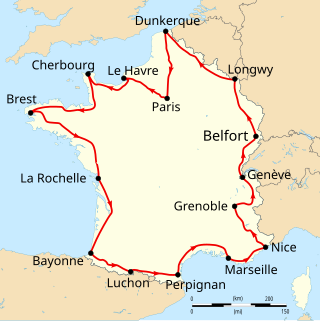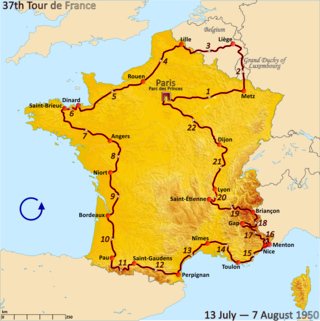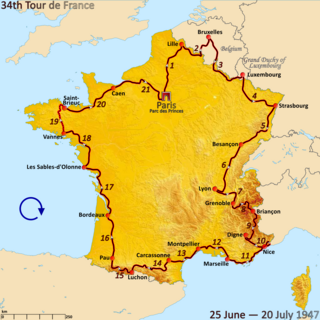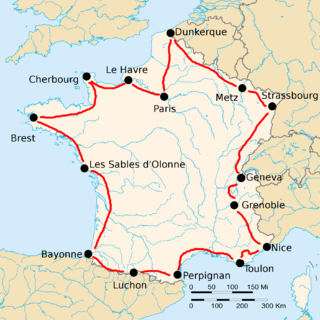
The Tour de France is an annual men's multiple-stage bicycle race held primarily in France. It is the oldest of the three Grand Tours and is generally considered the most prestigious.

The 1903 Tour de France was the first cycling race set up and sponsored by the newspaper L'Auto, ancestor of the current daily, L'Équipe. It ran from 1 to 19 July in six stages over 2,428 km (1,509 mi), and was won by Maurice Garin.

The 1904 Tour de France was the second Tour de France, held from 2 to 24 July. With a route similar to its previous edition, 1903 Tour de France winner Maurice Garin seemed to have repeated his win by a small margin over Lucien Pothier, while Hippolyte Aucouturier won four of the six stages. But the race became a victim of its own success, plagued by scandals; cyclists were accused of having taken trains during the race. Twelve cyclists, including the first four of the final classification and all stage winners, were disqualified by the Union Vélocipédique Française (UVF). Henri Cornet, originally the fifth-place finisher, was awarded the victory four months after the race. The problems caused the Tour de France to be provisionally cancelled, and subsequently the 1905 Tour de France was run with different rules from the 1903 and 1904 editions.

The 1914 Tour de France was the 12th edition of the Tour de France, taking place in 15 stages from 28 June to 26 July. The total distance was 5,380 kilometres (3,340 mi) and the average speed of the riders was 26.835 kilometres per hour (16.674 mph). It was won by the Belgian cyclist Philippe Thys.

The 1952 Tour de France was the 39th edition of the Tour de France, taking place from 25 June to 19 July. It was composed of 23 stages over 4,898 km (3,043 mi). Newly introduced were the arrivals on mountain peaks.

The 1962 Tour de France was the 49th edition of the Tour de France, one of cycling's Grand Tours. The 4,274-kilometre (2,656 mi) race consisted of 22 stages, including two split stages, starting in Nancy on 24 June and finishing at the Parc des Princes in Paris on 15 July. There were four time trial stages and no rest days. After more than 30 years, the Tour was again contested by trade teams instead of national teams. Jacques Anquetil of the Saint-Raphaël–Helyett–Hutchinson team won the overall general classification, defending his title to win his third Tour de France. Jef Planckaert (Flandria–Faema–Clément) placed second, 4 min 59 s in arrears, and Raymond Poulidor (Mercier–BP–Hutchinson) was third, over ten minutes behind Anquetil.

Pont-Aven School encompasses works of art influenced by the Breton town of Pont-Aven and its surroundings. Originally the term applied to works created in the artists' colony at Pont-Aven, which started to emerge in the 1850s and lasted until the beginning of the 20th century. Many of the artists were inspired by the works of Paul Gauguin, who spent extended periods in the area in the late 1880s and early 1890s. Their work is frequently characterised by the bold use of pure colour and their Symbolist choice of subject matter.

The 1908 Tour de France was the sixth running of the annual Tour de France, one of cycling's Grand Tours. It was organised by the newspaper L'Auto, and took place between 13 July and 9 August. The Tour was split in 14 stages, with a total distance of 4,497 kilometres (2,794 mi).

The 1963 Tour de France was the 50th instance of that Grand Tour. It took place between 23 June and 14 July, with 21 stages covering a distance of 4,138 km (2,571 mi). Stages 2 and 6 were both two part stages, the first half being a regular stage and the second half being a team or individual time trial.

The 1961 Tour de France was the 48th edition of the Tour de France, one of cycling's Grand Tours. It took place between 25 June and 16 July, with 21 stages covering a distance of 4,397 km (2,732 mi). Out of the 132 riders who started the tour, 72 managed to complete the tour's tough course. Throughout the 1961 Tour de France, two of the French national team's riders, André Darrigade and Jacques Anquetil held the yellow jersey for the entirety 21 stages. There was a great deal of excitement between the second and third places, concluding with Guido Carlesi stealing Charly Gaul's second-place position on the last day by two seconds.

The 1953 Tour de France was the 40th edition of the Tour de France, taking place from 3 to 26 July. It consisted of 22 stages over 4,476 km (2,781 mi).

The 1950 Tour de France was the 37th edition of the Tour de France, taking place from 13 July to 7 August. It consisted of 22 stages over 4,773 km (2,966 mi).

The 1947 Tour de France was the 34th edition of the Tour de France, taking place from 25 June to 20 July. The total race distance was 21 stages over 4,642 km (2,884 mi). It was the first Tour since 1939, having been cancelled during World War II, although some Tour de France-like races had been held during World War II.

The 1921 Tour de France was the 15th edition of the Tour de France, taking place 26 June to 24 July. The total distance was 5,485 km (3,408 mi) and the average speed of the riders was 24.720 km/h. The race was won by Belgian Leon Scieur. The Belgians dominated the entire race, partly due to the absence of the French Pélissier brothers, who were on bad terms with the Tour organisation. Scieur's victory was largely uncontested; Hector Heusghem came close after the sixth stage, but lost time later. The organisation tried to get the cyclists to attack more by several means, but this failed.

The 1927 Tour de France was the 21st edition of the Tour de France, taking place from 19 June to 17 July. It consisted of 24 stages over 5,398 km (3,354 mi).
Géo Lefèvre (1877–1961) was a French sports journalist and the originator of the idea for the Tour de France.

Lech Piasecki is a Polish former racing cyclist. Born in Poznań, he became the first Polish cyclist to wear the yellow jersey in the Tour de France, in 1987.

Peugeot team was a French professional cycling team that promoted and rode Peugeot racing bikes.
Pierre Desvages was a French cyclist of the early 1900s.
Payan or Payán is a surname. Notable people with the surname include:
















